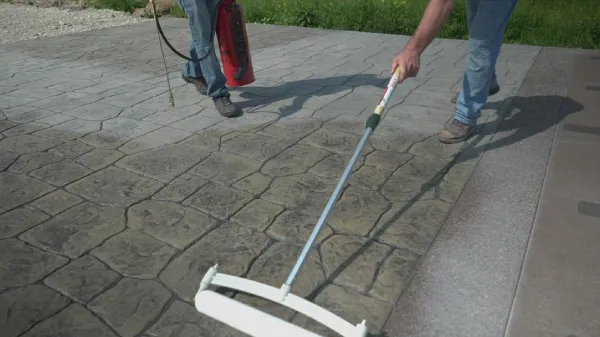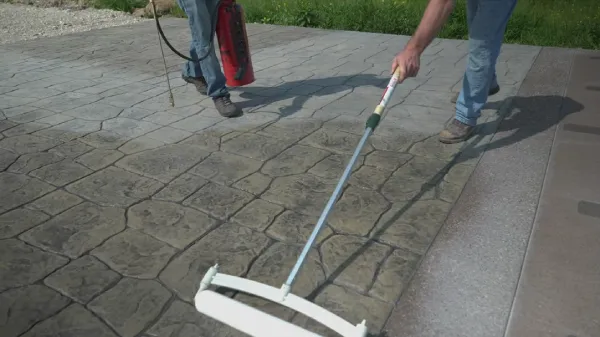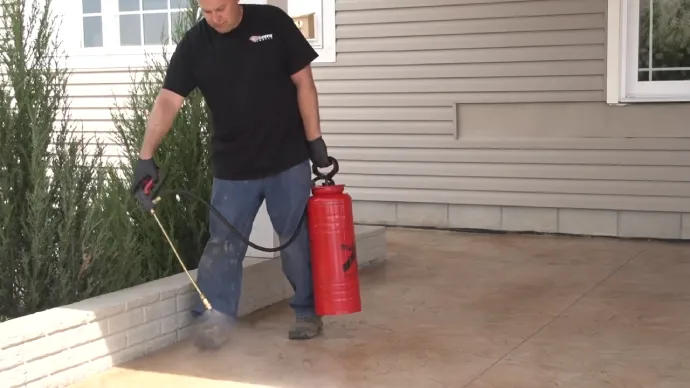Last Updated on January 20, 2023
Grout sealer is an extremely useful and popular tool for making concrete surfaces last longer and look better. It can help protect concrete from moisture damage, staining, discoloration, and other issues that can occur due to everyday wear and tear.
Grout sealer is also known for increasing the durability and longevity of concrete surfaces. While grout sealer has many advantages, there are also some disadvantages associated with it such as possible peeling or cracking of the finish and potential risk of contamination by chemicals in the sealer.
Therefore, it’s important to understand both the advantages and disadvantages before deciding to use grout sealer on your concrete surface. In this blog post, we will discuss the benefits and drawbacks of using grout sealer on concrete surfaces as well as guide you through the proper steps for application.
By understanding how to use grout sealers correctly, you can ensure that your concrete surfaces look their best while also protecting them from damage caused by everyday wear and tear.
Advantages of Using Grout Sealer on Concrete
Protection from Moisture Damage:
Applying grout sealer on concrete surfaces prevents moisture or water from penetrating or seeping into the material. Water can cause significant damage to concrete structures especially when exposed to extreme temperatures and when combined with other contaminants such as salt, oil spills, and other chemicals.
The grout sealer acts as a barrier which protects the surface from moisture-related issues like mold growth, mildew buildup, cracking due to expansion and contraction of materials in changing temperatures, deterioration of protective coatings, spalling or flaking of surfaces due to freeze-thaw cycles, and general weakening of materials due to absorption of liquids which may lead to severe structural damage if left unattended.
Prevention of Staining and Discoloration:
Additionally, grout sealers act as a layer that protects the surface from potential staining caused by dirt particles or spills such as grease, paint, wine stains etc., that could be difficult to remove once they settle into the porous material.
These stains are likely to discolor the surface permanently if not attended quickly; however with an effective grout sealer applied onto the surface it becomes easier to protect against any unwanted stain build up on the area that can later affect its overall appearance.
The sealing process also helps guard against fading colors due to external factors like direct sunlight exposure for prolonged periods or UV radiation which could deteriorate the original hue over time. It also makes it simpler for homeowners or business owners alike who are looking for lasting color options without having to do any regular maintenance work such repainting in order to maintain it.
Increased Durability and Longevity:
Lastly but most importantly, grout sealers help extend the life span of concrete structures significantly by providing increased strength against wear and tear over time thus avoiding costly repairs or replacements on newly built structures like driveways or walkways etc.
Additionally sealing off concrete prevents further damage by creating an extra protective shield over weak areas thereby reducing stress cracks caused by thermal expansion & contraction of materials especially during dry spells in hot climates where extreme temperature changes take place regularly leading to early deterioration of surfaces if left unprotected; this is especially beneficial for those who live in such regions prone to frequent climate shifts throughout the year.
Moreover when compared with commonly opted alternative methods such as painting which is short term solution that requires regular touch ups due environmental exposures; using grout sealers offer permanent solutions with minimal upkeeps at low costs which makes it more attractive option for many property owners looking for long lasting solutions without spending too much money upfront
Disadvantages of Using Grout Sealer on Concrete
Possible Peeling or Cracking of Finish:
One of the primary issues associated with applying a grout sealer to concrete is the potential for peeling or cracking over time. As temperatures fluctuate throughout the year, the sealer may begin to break down due to expansion and contraction of the concrete surface beneath it.
This can create visible cracks in the sealer’s finish which will ultimately lead to premature breakdown of the material’s protective properties. Additionally, if too much water is used during application or if moisture gets trapped beneath the coating due to improper drying following application, then this too can lead to peeling or cracking over time that can compromise its effectiveness.
Possible Risk of Contamination by Chemicals in the Sealer:
Another disadvantage associated with using a grout sealer on concrete is the potential risk of contamination due to chemicals contained within it.
Depending on what type of grout sealer is being used and its contents (some can contain solvents such as mineral spirits), there is a risk that these chemicals can seep into surrounding areas making them unsafe for use around food or children’s toys etc.
In some cases this could require special measures such as sealing off vents and windows in order to prevent contamination from occurring – something that could add considerable effort and cost associated with application process. Finally, some grout sealers also have high levels of VOC’s which are known pollutants so it’s important to take this into consideration when selecting one for your project.
How to Apply Grout Sealer on Concrete Surfaces

Preparation of Surface Before Application of Grout Sealer
Cleaning with Mild Detergent and Water Solution
Before applying a grout sealer on concrete surfaces, it is important to ensure that the surface is thoroughly cleaned with a mild detergent and water solution. This can be done by scrubbing the surface with a stiff brush or cleaning cloth, rinsing it off with lukewarm water, and allowing it to dry completely before proceeding with the application process.
The use of a mild detergent will help remove any dirt, dust and other debris that could affect the look and performance of the grout sealer. After cleaning, it is also important to check whether there are any cracks or holes in the concrete which need to be filled before applying the sealant.
Removing Debris and Residue from Surface with Brush and Vacuum Cleaner
Once the surface has been cleaned, all excess debris must be removed from the area using either a brush or vacuum cleaner. The use of either method is effective in removing any dirt particles that may have been left behind during cleaning or from prior applications of materials such as paint or epoxy.
It is important to ensure that no residue is left on the surface as this can cause problems for later steps in applying grout sealants. A vacuum cleaner works best for this task as it can reach into corners and other areas where a brush cannot access easily.
Application of Primer (if Necessary) to Enhance Bonding Capabilities
In some cases, using a primer may be necessary before applying grout sealers on concrete surfaces. This is especially true if there are existing coatings or paints on the surface since these can create an uneven base which prevents proper adhesion between the grout sealant and concrete substrate.
A primer acts as an intermediary layer between these two surfaces which ensures better bonding capabilities when applying grout sealers. When choosing a primer for this purpose, make sure that it has excellent adhesion qualities compatible with both surfaces being bonded together i.e., concrete substrate and grout sealant material for best results in durable adhesion over time.
Applying the Grout Sealer Properly
Determining Best Method for Application Depending on Type of Grout Sealer Used
When applying grout sealer to concrete surfaces, determining the best method of application is often based upon the type of sealer being used. For example, some sealers are designed to be applied with a brush or roller while others are meant to be sprayed onto the surface.
When using a brush or roller, it is important to ensure that the sealant is spread evenly and there are no gaps between strokes. Additionally, it is also important to select a brush or roller with a soft bristled head specially designed for grout work in order to avoid any potential damage to the surface during application.
When using a spray-on sealant, it is important that users utilize proper safety precautions such as wearing eye and breathing protection when spraying due to an aerosolized mist which can occur during application.
Additionally, spray-on sealants should only be applied outdoors or in well-ventilated areas in order to prevent potential respiratory irritations from prolonged exposure.
Furthermore, when spraying any type of grout sealant onto concrete surfaces it is essential that users apply even pressure while moving back and forth until complete coverage has been achieved over all areas requiring protection.
Following Directions for Proper Amount, Technique, and Duration for Application
Regardless of the type of grout sealer used on concrete surfaces, it’s very important that directions are closely followed in regards to proper amount and duration for application along with any special techniques required for optimal results.
This means that users should always take time to read through each product’s label carefully before starting any sealing project as this will ensure they have all necessary information needed before beginning any job including: how much material needs to be used; how long it should dry; how many coats should be applied; what types of items should not come into contact with the surface while drying; what types of finishes can be expected after completion; etc.
Additionally, directions found on labels may also provide special instructions such as pre-wetting certain types of surfaces prior to begin sealing job or recommendations regarding primers and additional coatings which may need added depending on specific jobsite requirements.
Ensuring Complete Coverage of Joints and Other Areas Requiring Protection
In order achieve optimal results when applying grout seals onto concrete surfaces, ensuring complete coverage over all joints along with other areas requiring protection such as corners must also be considered during application process in order achieve lasting performance from these products throughout their lifetime.
To do this properly without leaving behind gaps during sealing process it’s often recommended that users use a brush or small foam applicator along edges where detailed work needs done in order fill in cracks and crevices which could potentially lead too premature failure from exposure if left sealed unprotected.
Additionally , since most grout lines run vertically when completing sealing job these same tools can often reach deep into vertical cracks where traditional brushes won’t fit , thus making them ideal choice when attempting reach hard to -reach areas which may otherwise remain unsealed if not done properly.
Does grout sealer make it waterproof?
Yes, grout sealer can make concrete water-resistant. When applied to the surface of a concrete floor, it helps prevent moisture from seeping through and damaging the underlying material. The sealer also prevents dirt, dust, and other debris from settling into the grout lines between tiles. This helps ensure that the area is maintained in a clean and hygienic condition.
Additionally, the sealer creates an invisible barrier that prevents dirt and other contaminants from becoming embedded into the concrete itself. As a result, it extends the longevity of your floors as well as enhances their appearance.
How do you waterproof gaps in concrete?

Waterproofing gaps in concrete is important when trying to protect structures against water damage. The best way to do this is by using a waterproof coating or sealant on top of the surface before applying a finishing layer such as epoxy or polyurethane.
This will help fill any cracks or crevices that may be present and prevent water from penetrating through them into the underlying material. Additionally, you can also use a waterproofing membrane underneath your finished layer for added protection against moisture intrusion.
Is water-based sealer good for concrete?
Yes, water-based sealers are generally considered to be good for sealing concrete surfaces because they are breathable which allows moisture trapped beneath them to escape without causing damage to the surface above it.
Water-based sealers tend to be less glossy than solvent-based versions but still provide adequate levels of protection against wear and tear while enhancing the look of asphalt surfaces without making them slippery when wet. In addition, they are relatively easy to apply with minimal effort required compared to solvent-based products.
Why do contractors not seal grout?
Contractors often choose not to seal grout due to several reasons including cost effectiveness, aesthetics and ease of application. While grout does require sealing periodically in order for it to remain strong and intact over time; this process can prove costly if not done correctly or if done more frequently than necessary.
Additionally, some contractors may feel that applying a coating overtop of grout detracts from its natural aesthetic appeal as opposed to leaving it exposed without any additional treatment which might improve its overall visual quality in comparison with sealed options.
Finally, sealing grout can be quite tedious depending on its size which means extra effort has to go into ensuring that all areas have been properly treated with minimal wastage involved during application processes; something which could potentially discourage contractors from opting for this type of service altogether if they don’t believe that its benefits outweigh its drawbacks when taking into account certain budget constraints or working parameters associated with each project at hand.
Conclusion:
Overall, using a grout sealer on concrete surfaces can be a great way to protect your investment while also providing a professional level of protection against stains, discoloration, moisture damage, and other problems caused by everyday wear and tear.
However, you should be aware of potential downsides such as peeling or cracking of the finish or contamination by chemicals in the sealer when applying grout sealers correctly. Before applying any type of grout sealer to your concrete surface, make sure to read all instructions carefully and thoroughly clean the surface beforehand with mild detergent solution before proceeding with primer (if necessary) to enhance bonding capabilities.
With these tips in mind along with full understanding of both the pros and cons associated with using grout sealers on your concrete surfaces, you can confidently enjoy longer lasting beauty and protection for years to come!


